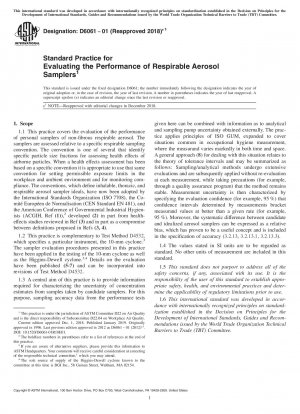ASTM D6061-01(2018)e1
Standard Practice for Evaluating the Performance of Respirable Aerosol Samplers
- Standard No.
- ASTM D6061-01(2018)e1
- Release Date
- 2018
- Published By
- American Society for Testing and Materials (ASTM)
- Latest
- ASTM D6061-01(2018)e1
- Scope
- 1.1 This practice covers the evaluation of the performance of personal samplers of non-fibrous respirable aerosol. The samplers are assessed relative to a specific respirable sampling convention. The convention is one of several that identify specific particle size fractions for assessing health effects of airborne particles. When a health effects assessment has been based on a specific convention it is appropriate to use that same convention for setting permissible exposure limits in the workplace and ambient environment and for monitoring compliance. The conventions, which define inhalable, thoracic, and respirable aerosol sampler ideals, have now been adopted by the International Standards Organization (ISO 7708), the Comité Européen de Normalisation (CEN Standard EN 481), and the American Conference of Governmental Industrial Hygienists (ACGIH, Ref (1)),2 developed (2) in part from healtheffects studies reviewed in Ref (3) and in part as a compromise between definitions proposed in Refs (3, 4). 1.2 This practice is complementary to Test Method D4532, which specifies a particular instrument, the 10-mm cyclone.3 The sampler evaluation procedures presented in this practice have been applied in the testing of the 10-mm cyclone as well as the Higgins-Dewell cyclone.3,4 Details on the evaluation have been published (5-7) and can be incorporated into revisions of Test Method D4532. 1.3 A central aim of this practice is to provide information required for characterizing the uncertainty of concentration estimates from samples taken by candidate samplers. For this purpose, sampling accuracy data from the performance tests given here can be combined with information as to analytical and sampling pump uncertainty obtained externally. The practice applies principles of ISO GUM, expanded to cover situations common in occupational hygiene measurement, where the measurand varies markedly in both time and space. A general approach (8) for dealing with this situation relates to the theory of tolerance intervals and may be summarized as follows: Sampling/analytical methods undergo extensive evaluations and are subsequently applied without re-evaluation at each measurement, while taking precautions (for example, through a quality assurance program) that the method remains stable. Measurement uncertainty is then characterized by specifying the evaluation confidence (for example, 95 %) that confidence intervals determined by measurements bracket measurand values at better than a given rate (for example, 95 %). Moreover, the systematic difference between candidate and idealized aerosol samplers can be expressed as a relative bias, which has proven to be a useful concept and is included in the specification of accuracy (3.2.13, 3.2.13.1, 3.2.13.3). 1.4 The values stated in SI units are to be regarded as standard. No other units of measurement are included in this standard. 1.5 This standard does not purport to address all of the safety concerns, if any, associated with its use. It is the responsibility of the user of this standard to establish appropriate safety, health, and environmental practices and determine the applicability of regulatory limitations prior to use. 1.6 This international standard was developed in accordance with internationally recognized principles on standardization established in the Decision on Principles for the Development of International Standards, Guides and Recommendations issued by the World Trade Organization Technical Barriers to Trade (TBT) Committee. 1 This practice is under the jurisdiction of ASTM Committee D22 on Air Quality and is the direct responsibility of Subcommittee D22.04 on Workplace Air Quality. Current edition approved Dec. 1, 2018. Published January 2019. Originally approved in 1996. Last previous edition approved in 2012 as D6061 – 01 (2012)ε1 . DOI: 10.1520/D6061-01R18E01. 2 The boldface numbers in parentheses refer to a list of references at the end of this practice. 3 If you are aware of alternative suppliers, please provide this information to ASTM Headquarters. Your comments will receive careful consideration at a meeting of the responsible technical committee,1 which you may attend. 4 The sole source of supply of the Higgins-Dewell cyclone known to the committee at this time is BGI Inc., 58 Guinan Street, Waltham, MA 02154. Copyright © ASTM International, 100 Barr Harbor Drive, PO Box C700, West Conshohocken, PA 19428-2959. United States This international standard was developed in accordance with internationally recognized principles on standardization established in the Decision on Principles for the Development of International Standards, Guides and Recommendations issued by the World Trade Organization Technical Barriers to Trade (TBT) Committee. 1 2. Referenced Documents
ASTM D6061-01(2018)e1 Referenced Document
- ASTM D1356 Standard Terminology Relating to Sampling and Analysis of Atmospheres*, 2024-04-21 Update
- ASTM D4532 Standard Test Method for Respirable Dust in Workplace Atmospheres
- ASTM D6062 Standard Guide for Personal Samplers of Health-Related Aerosol Fractions
- ASTM D6552 Standard Practice for Controlling and Characterizing Errors in Weighing Collected Aerosols*, 2021-09-01 Update
- ISO 7708 Air quality - Particle size fraction definitions for health-related sampling
ASTM D6061-01(2018)e1 history
- 2018 ASTM D6061-01(2018)e1 Standard Practice for Evaluating the Performance of Respirable Aerosol Samplers
- 2001 ASTM D6061-01(2012)e1 Standard Practice for Evaluating the Performance of Respirable Aerosol Samplers
- 2001 ASTM D6061-01(2007)e1 Standard Practice for Evaluating the Performance of Respirable Aerosol Samplers
- 2001 ASTM D6061-01 Standard Practice for Evaluating the Performance of Respirable Aerosol Samplers
- 1996 ASTM D6061-96 Standard Practice for Evaluating the Performance of Respirable Aerosol Samplers
